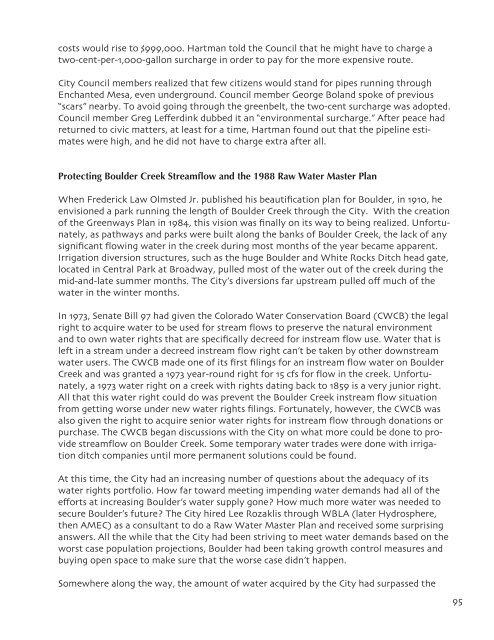You also want an ePaper? Increase the reach of your titles
YUMPU automatically turns print PDFs into web optimized ePapers that Google loves.
costs would rise to $999,000. Hartman told the Council that he might have to charge a<br />
two-cent-per-1,000-gallon surcharge in order to pay for the more expensive route.<br />
City Council members realized that few citizens would stand for pipes running through<br />
Enchanted Mesa, even underground. Council member George Boland spoke of previous<br />
“scars” nearby. To avoid going through the greenbelt, the two-cent surcharge was adopted.<br />
Council member Greg Lefferdink dubbed it an “environmental surcharge.” After peace had<br />
returned to civic matters, at least for a time, Hartman found out that the pipeline estimates<br />
were high, and he did not have to charge extra after all.<br />
Protecting Boulder Creek Streamflow and the 1988 Raw Water Master Plan<br />
When Frederick Law Olmsted Jr. published his beautification plan for Boulder, in 1910, he<br />
envisioned a park running the length of Boulder Creek through the City. With the creation<br />
of the Greenways Plan in 1984, this vision was finally on its way to being realized. Unfortunately,<br />
as pathways and parks were built along the banks of Boulder Creek, the lack of any<br />
significant flowing water in the creek during most months of the year became apparent.<br />
Irrigation diversion structures, such as the huge Boulder and White Rocks Ditch head gate,<br />
located in Central Park at Broadway, pulled most of the water out of the creek during the<br />
mid-and-late summer months. The City’s diversions far upstream pulled off much of the<br />
water in the winter months.<br />
In 1973, Senate Bill 97 had given the Colorado Water Conservation Board (CWCB) the legal<br />
right to acquire water to be used for stream flows to preserve the natural environment<br />
and to own water rights that are specifically decreed for instream flow use. Water that is<br />
left in a stream under a decreed instream flow right can’t be taken by other downstream<br />
water users. The CWCB made one of its first filings for an instream flow water on Boulder<br />
Creek and was granted a 1973 year-round right for 15 cfs for flow in the creek. Unfortunately,<br />
a 1973 water right on a creek with rights dating back to 1859 is a very junior right.<br />
All that this water right could do was prevent the Boulder Creek instream flow situation<br />
from getting worse under new water rights filings. Fortunately, however, the CWCB was<br />
also given the right to acquire senior water rights for instream flow through donations or<br />
purchase. The CWCB began discussions with the City on what more could be done to provide<br />
streamflow on Boulder Creek. Some temporary water trades were done with irrigation<br />
ditch companies until more permanent solutions could be found.<br />
At this time, the City had an increasing number of questions about the adequacy of its<br />
water rights portfolio. How far toward meeting impending water demands had all of the<br />
efforts at increasing Boulder’s water supply gone? How much more water was needed to<br />
secure Boulder’s future? The City hired Lee Rozaklis through WBLA (later Hydrosphere,<br />
then AMEC) as a consultant to do a Raw Water Master Plan and received some surprising<br />
answers. All the while that the City had been striving to meet water demands based on the<br />
worst case population projections, Boulder had been taking growth control measures and<br />
buying open space to make sure that the worse case didn’t happen.<br />
Somewhere along the way, the amount of water acquired by the City had surpassed the<br />
95



